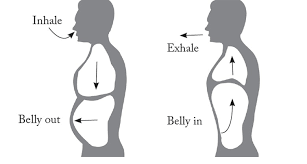Here we are looking at a simple exercise to help protect your back, but it brings so much more besides. So simple that it doesn’t really look like an exercise, but it may well take some concentration. We really are starting on the ground floor here, so no excuses, people!
BREATHING!
We all move air in and out – or ventilate – just fine and this keeps us alive but does nothing else. Breathing is a whole different thing and when we do it well, it allows the muscles in our shoulders and necks to relax, it supports our spines and can contribute to a sense of calm by helping to normalise blood gases (as demonstrated in extremis when breathing into a paper bag to help with panic-attacks). We all ventilate just fine, but most of us don’t breath.
Most of us predominantly use our upper chest and ribcage to move air, meaning that we lift our ribcage, shoulders, arms and breasts 15 times per minute, all day. This is called Apex Breathing, which is a lot of work! It drives our neck and shoulder muscles tighter and tighter over time, drives us into a fight-or-flight stressed state, and switches off our core stabilising muscles, which is the opposite of what we are looking for here.
If we predominantly use our DIAPHRAGM to breath, we pull air deeper down into our lungs, we exercise and strengthen our diaphragm muscle which just happens to be a vital part of our spine stability system, and we get to relax all the muscles in our necks and shoulders. This is variously called Belly Breathing, Ventral Breathing, Abdominal Breathing, and any medical doctor, psychiatrist or musculoskeletal specialist, as well as the whole complimentary health and wellbeing community will agree that good things happen when we stop apex-breathing and start abdominal breathing.
What does Ventral Breathing look like?

This will feel very normal to some and very wrong and counter-intuitive to those with a strongly ingrained Apex Breathing pattern.
Learning to Ventral Breath – key points:
Lie on your back, one hand on your chest and one hand on your belly between sternum and ribcage.
Feel for which hand moves up and down the most. We are aiming for most of the movement to be in the belly hand.
You may need to think about artificially puffing your belly out towards the ceiling as you allow air to flow in.
Keep the breathing gentle and relatively shallow at first. A ‘deep breath’ will tend to make you default to old Apex Breathing habits.
Like any new skill, this will take repetition and time to become an ingrained habit, but if you do the work you will get there.
Useful resources:
The British Lung Foundation – a great anatomy primer. Scroll down the page to Breathing Control.
https://www.blf.org.uk/support-for-you/breathlessness/how-to-manage-breathlessness
TEDTalk – this is inspiring.
Instructional video – this give you some great close-ups of what to do!
Your Exercise Prescription:
Spend 5 minutes on your back when you first wake up practicing ventral breathing.
Every time you sit down spend 20 seconds thinking about ventrally breathing.
Every time you stand up, spend 20 seconds thinking about ventral breathing.
Hopefully you (and others around you) will notice that your shoulders are dropping and you appear more relaxed. Otherwise there will be no outward sign that you are exercising!
Some final thoughts:
Does this mean I never use my ribcage for breathing again?
No. Ventral breathing is our solid foundation. If we need to breath harder, then we can start to flare our ribs, and when we are really breathing hard, we add the apex breathing on the top, but the diaphragm needs to be the working 24/7, regardless of how hard we are working.
Why don’t we all Ventrally breath naturally?
A lifetime of societal pressure to “suck-it-in, shoulders back, chest out” messing you up. If you have pre-school kids in the family, imagine them running around the garden with their tops off, and visualise how they breath. They are like little balloons inflating and deflating around their bellies. They haven’t learned to breath wrongly yet!
Is this what I have learned at Yoga, Pilates, TaiChi, the Asthma clinic, Respiratory Outpatients?
With subtle variations and nuances, Yes! The big message here is to get the default breathing pattern out of the top of the lungs and down into the diaphragm.
